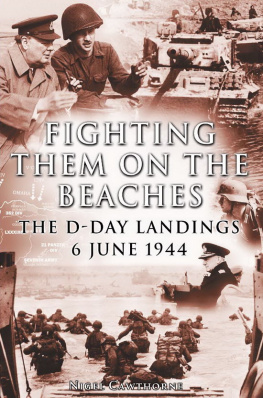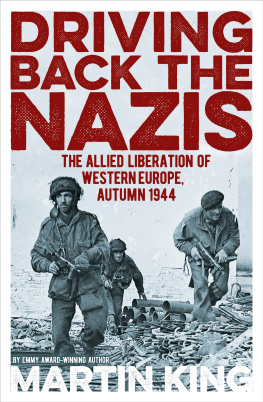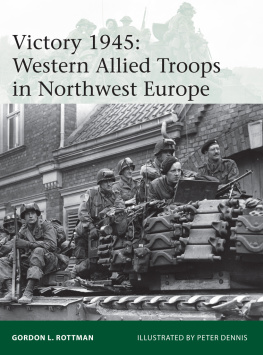Karen Farrington - Victory in Europe: D-Day to the Fall of Berlin
Here you can read online Karen Farrington - Victory in Europe: D-Day to the Fall of Berlin full text of the book (entire story) in english for free. Download pdf and epub, get meaning, cover and reviews about this ebook. year: 2005, publisher: Arcturus Digital Limited, genre: Non-fiction. Description of the work, (preface) as well as reviews are available. Best literature library LitArk.com created for fans of good reading and offers a wide selection of genres:
Romance novel
Science fiction
Adventure
Detective
Science
History
Home and family
Prose
Art
Politics
Computer
Non-fiction
Religion
Business
Children
Humor
Choose a favorite category and find really read worthwhile books. Enjoy immersion in the world of imagination, feel the emotions of the characters or learn something new for yourself, make an fascinating discovery.
- Book:Victory in Europe: D-Day to the Fall of Berlin
- Author:
- Publisher:Arcturus Digital Limited
- Genre:
- Year:2005
- Rating:4 / 5
- Favourites:Add to favourites
- Your mark:
- 80
- 1
- 2
- 3
- 4
- 5
Victory in Europe: D-Day to the Fall of Berlin: summary, description and annotation
We offer to read an annotation, description, summary or preface (depends on what the author of the book "Victory in Europe: D-Day to the Fall of Berlin" wrote himself). If you haven't found the necessary information about the book — write in the comments, we will try to find it.
By midnight on 6 June 1944, the future of Europe hung in the balance. Allied troops occupied beachheads as Hitlers troops threatened to drive them back into the sea. Karen Farrington presents this remarkable story of the final Allied liberation and the push through to Berlin, the beating heart of the Third Reich.
Victory in Europe: D-Day to the Fall of Berlin — read online for free the complete book (whole text) full work
Below is the text of the book, divided by pages. System saving the place of the last page read, allows you to conveniently read the book "Victory in Europe: D-Day to the Fall of Berlin" online for free, without having to search again every time where you left off. Put a bookmark, and you can go to the page where you finished reading at any time.
Font size:
Interval:
Bookmark:

CHAPTER ONE
Building up to Invasion
This war will be won or lost on the beaches
Field Marshal Gerd von Rundstedt, June 1944
W ith hindsight, it seems inevitable that once the Allies had a foothold in Normandy, they would blithely roll through France, into Germany and straight to the heart of the Third Reich, ending Hitlers boast of a thousand-year reign. In fact, the advance could have stalled, or even been thrown back, on numerous occasions. If the Fhrers promise of secret weapons had amounted to more than just a promise, Europe and the world might today be of a rather different character.
Although in popular imagining the D in D-Day stands for Deliverance, in actual fact D simply stands for day: the day of any military operation is referred to as D-Day, just as the exact hour of its launch is known as H-Hour. That the term should today carry quasi-religious overtones stands as testimony to the unspeakable evil of the regime from which mainland Europe was liberated. The resolve to free Europe took shape almost at the moment the last soldier of the BEF, the British Expeditionary Force, was evacuated from Dunkirk in May 1940. The USA became equally convinced of the merit of liberation after Hitler hastily, and somewhat unwisely, declared war on the US in 1941 following the Japanese sneak attack on Pearl Harbor. Even prior to this incident, however, President Franklin Delano Roosevelt was convinced that a Hitler allowed to consolidate his territorial gains would ultimately come to threaten the security of the US itself.
In the modern era, it is unthinkable that a brutal dictatorship could hold sway over Europe: this, however, is exactly what did happen for four long years after German tanks rushed through France in 1940. The Nazis their power by now unchallenged in Germany roared across the continent to the blood-curdling sound of the Stuka dive-bomber, reaching the French coast in just six weeks, a feat the generals of the First World War were unable to achieve in four years.
Operation Sealion
Having lost large numbers of men and materiel in France, the British army was severely understrength and under-equipped and had Hitler decided on a full-scale invasion of the British Isles, there is the likelihood that he may have succeeded. But the Wehrmacht was unprepared for an amphibious assault on this scale, and the High Command was canny enough to recognise this. Disputes between the German army and navy about the logistics of the invasion persuaded Hitler to postpone Operation Sealion, as the operation had been code-named, turning to Grings Luftwaffe to win control of the skies as a prelude to invasion. The future of the war lay in the hands of the few Royal Air Force pilots and they prevailed. Operation Sealion was shelved indefinitely.
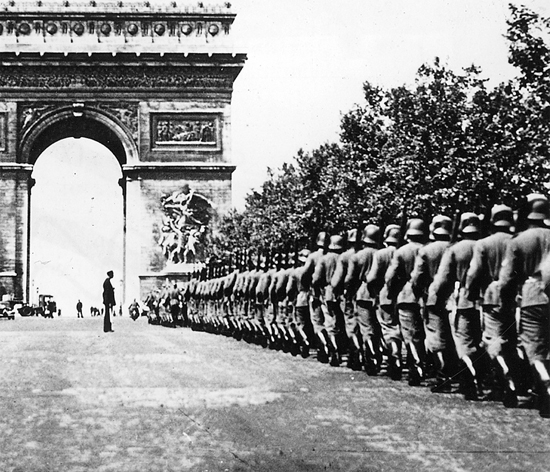
German troops
in front of the Eiffel Tower, Paris. The speed of the Nazi victory in France took everyone, including Hitler, by surprise.
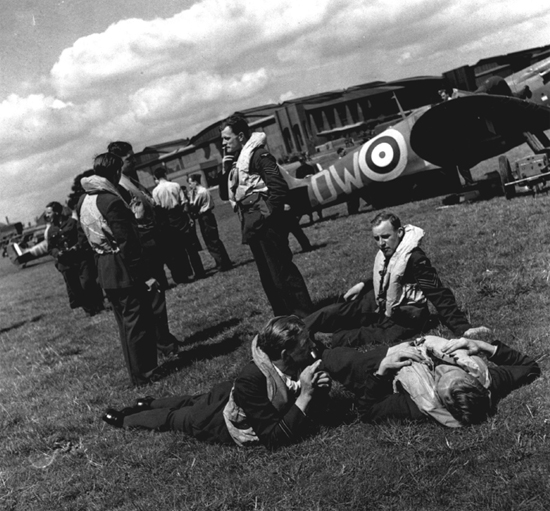
August 1940
Pilots of No 610 County of Chester Squadron, Royal Auxiliary Air Force resting and talking around their Supermarine Spitfire I fighters on Hawkinge airfield during a lull in the Battle of Britain.
Still clinging to the hope that Britain would sue for peace, Hitler turned his attentions to the Soviet Union, giving British military planners precious time to plot the liberation of Europe. Outside the occupied territories of Europe the conflict raged across many fronts, and the Allies began to have serious discussions about the hazards of invasions.
Valuable lessons were learned with the aborted invasion-style raid on Dieppe in August 1942 although the price was high: the death or capture of some 4,000 Canadian troops.
The Lessons of Dieppe
Firstly, the operation at Dieppe underlined the need for secrecy. At the French port the defending Germans were expecting some action and were well-prepared. Secondly, the Navys heavy cruisers and battleships would be sorely needed during a large-scale action. At the time the Dieppe raid took place, the Royal Navy was exercising extreme caution in permitting ships into the exposed English Channel and, on this occasion, allowed nothing bigger than a destroyer into the waters to protect the men going ashore. Air supremacy also proved to be crucial, another element missing at Dieppe. Poor communications between beach and operation commanders meant waves of men were sent ashore when they had no hope of survival. This was a further issue that urgently needed addressing as was the lack of meaningful reconnaissance. Many soldiers deposited at Dieppe had no idea where to exit the beach. There was, following Dieppe, a clear need for specialist amphibious craft to protect men emerging from the waters. Perhaps most importantly, the Dieppe fiasco served to highlight the perils of attempting any invasion against established fortifications. As for the Germans, the debacle at Dieppe made them feel impregnable and perhaps contributed to an air of complacency.
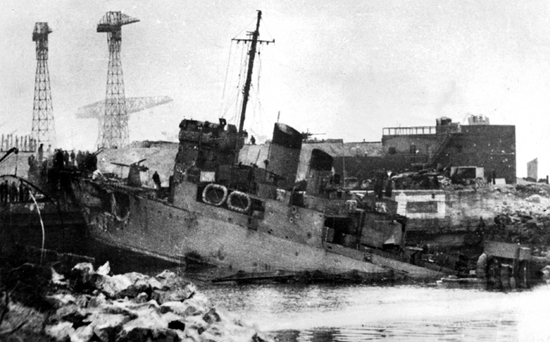
St Nazaire raids
The Campbelltown at St Nazaire in the sluice just before she blew up, taking the sluice gate with her.

Allies united
General Eisenhower greets Free French leader Charles de Gaulle at a meeting of Allied Chiefs in England on the eve of D-Day. Host of the meeting Winston Churchill stands behind them.
There were other, more successful landings for the Allies to consider, such as the attack at Vaagso in Norway at the end of 1941, the sabotage of St Nazaire in March 1942 and the so-called Torch landings that propelled additional Allied troops into North Africa in the wake of the success at El Alamein. However, all were on a much smaller scale than D-Day, with far less at stake.
D-Day was a highly ambitious amphibious landing intended to bring a speedy end to the war. Any hitches or reversals would have meant prolonging the conflict, with the additional loss of life that would have involved. In terms of men and materiel, it was a massive undertaking, testing strategy and organisation to the utmost. As Churchill reminded Overlord commanders: This is an invasion, not the creation of a fortified beachhead.
Plans were drafted and re-drafted. Whatever his personality clashes with higher officers may have been, the British Field Marshal Sir Bernard Law Montgomery was swift to assess an initial plan as too small. He wanted a much bigger and broader thrust into France in order to prevent the invading forces simply being squeezed back into the sea.
The War of Secrets
The Allies had a fair idea of what awaited them in France. For several years the hierarchy had had access to Germanys military secrets after the Reichs highly complex Enigma code was broken. Germany had been producing Enigma machines since before the war, which, simply put, were typewriter style devices with rotor wheels and plug boards that automatically replaced one letter for another to provide a uniform code. Message recipients also in possession of an Enigma machine simply adjusted their rotors to read off the correctly transposed words. The rotor settings changed on a daily basis. Without specialist knowledge the codes were hopelessly obscure. In fact, the complexity of the encoding system was such that the code-breakers had a one in 150,000,000,000,000,000,000 chance of stumbling across the right answer purely by chance. The German generals sincerely believed the system was impregnable simply because no one would have the time to tackle it. They overlooked some obvious weaknesses: that numbers had to be written in full, that no letter could stand for itself, and that each message began with a weather forecast. They also reckoned without the brilliant mathematicians in Britain who did crack the Enigma code and used it to help Britain win the Battle of the Atlantic by guiding shipping away from known U boat movements.
Font size:
Interval:
Bookmark:
Similar books «Victory in Europe: D-Day to the Fall of Berlin»
Look at similar books to Victory in Europe: D-Day to the Fall of Berlin. We have selected literature similar in name and meaning in the hope of providing readers with more options to find new, interesting, not yet read works.
Discussion, reviews of the book Victory in Europe: D-Day to the Fall of Berlin and just readers' own opinions. Leave your comments, write what you think about the work, its meaning or the main characters. Specify what exactly you liked and what you didn't like, and why you think so.








